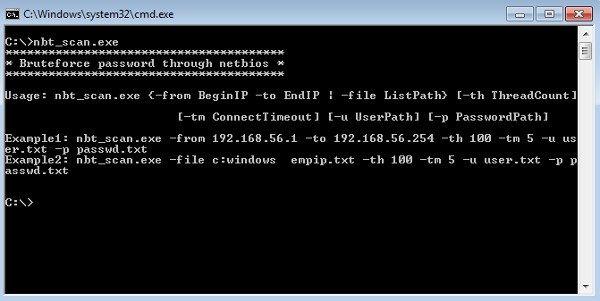HKTL_NBTSCAN.GA
Windows


Threat Type: Hacking Tool
Destructiveness: No
Encrypted: No
In the wild: Yes
OVERVIEW
This hacking tool arrives on a system as a file dropped by other malware or as a file downloaded unknowingly by users when visiting malicious sites. It may be manually installed by a user.
TECHNICAL DETAILS
Arrival Details
This hacking tool arrives on a system as a file dropped by other malware or as a file downloaded unknowingly by users when visiting malicious sites.
It may be manually installed by a user.
Dropping Routine
This hacking tool drops the following files:
- {Malware Path}\{Malware's Filename}.log -> Log file that contains the information gathered by the hacktool upon connecting to the IP Range set by the malware by using the Username/Password listed on .txt files which was also set by the malware (Brute Force). The said information listed on the logs are:
- {IP Address}|{User}|{Domain}|{Hostname}|{OS Version}|{Username that worked}|{Password that worked}|{File Copy Result}
where:- {File Copy Result} could be "Success" or "Failed"
Note: The default Filename for the log file is: nbt_scan.log - {IP Address}|{User}|{Domain}|{Hostname}|{OS Version}|{Username that worked}|{Password that worked}|{File Copy Result}
Other Details
This hacking tool does the following:
- This hacking tool is a command line program which is capable of scanning IP networks for NetBIOS information.
- It may list IP addresses, NetBIOS computer names, user names and MAC addresses
- Upon successful connection of the malware, it will try to copy "%System%\calc.exe" of the attacker machine to the targeted machine: "{IP with successful connection}\C$\windows\temp\fwtsqmfile0010.sqm"
(Note: %System% is the Windows system folder, where it usually is C:\Windows\System32 on all Windows operating system versions.)
NOTES:
It displays the following commandline instructions:

SOLUTION
Step 1
Before doing any scans, Windows XP, Windows Vista, and Windows 7 users must disable System Restore to allow full scanning of their computers.
Step 2
Note that not all files, folders, and registry keys and entries are installed on your computer during this malware's/spyware's/grayware's execution. This may be due to incomplete installation or other operating system conditions. If you do not find the same files/folders/registry information, please proceed to the next step.
Step 3
Search and delete this file
- {Malware Path}\{Malware's Filename}.log
- {Malware Path}\nbt_scan.log
- {IP with successful connection}\C$\windows\temp\fwtsqmfile0010.sqm
Step 4
Scan your computer with your Trend Micro product to delete files detected as HKTL_NBTSCAN.GA. If the detected files have already been cleaned, deleted, or quarantined by your Trend Micro product, no further step is required. You may opt to simply delete the quarantined files. Please check this Knowledge Base page for more information.
Did this description help? Tell us how we did.


